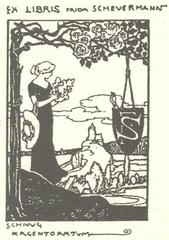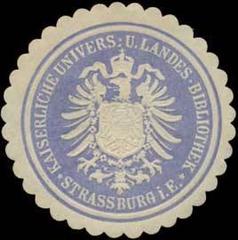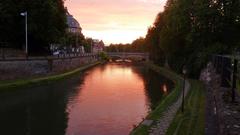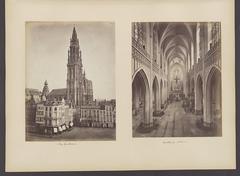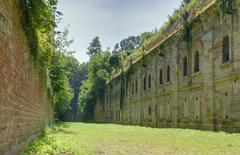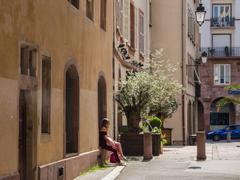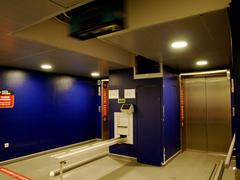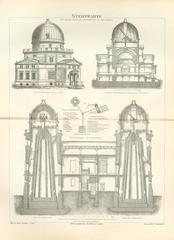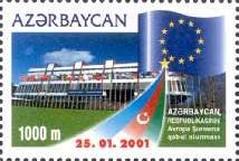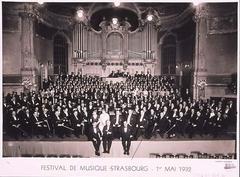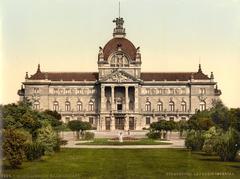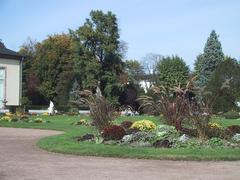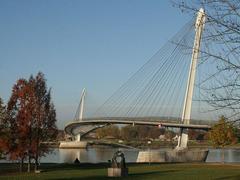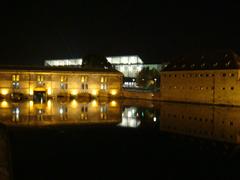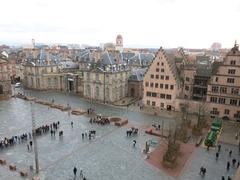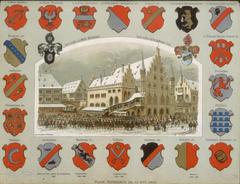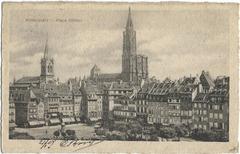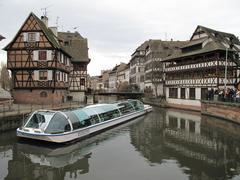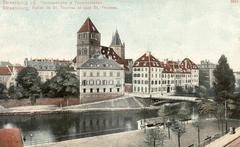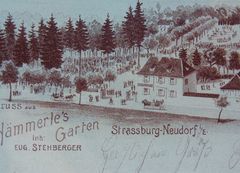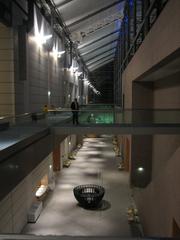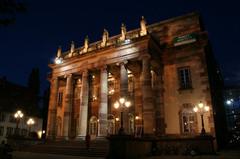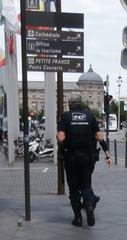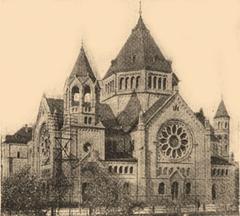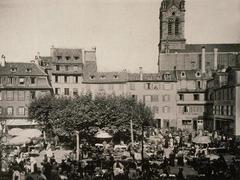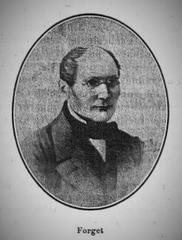
Old Saint Peter’s Church Strasbourg: Visiting Hours, Tickets, and Historical Sites Guide
Date: 03/07/2025
Introduction
Old Saint Peter’s Church (Église Saint-Pierre-le-Vieux) in Strasbourg stands as one of the city’s most compelling historical and architectural landmarks. Its unique “simultaneum” arrangement—hosting both Catholic and Lutheran congregations under one roof since the late 17th century—reflects Strasbourg’s complex religious history and spirit of coexistence. The church, with origins dating back to early Christian activity in the 4th century, welcomes visitors to explore its layered past, from Romanesque and Gothic architecture to Baroque embellishments and contemporary community life.
Nestled in the heart of Strasbourg’s UNESCO-listed Grande Île, Old Saint Peter’s Church is more than a place of worship; it is a living testament to centuries of religious dialogue, artistic heritage, and urban development. This comprehensive guide will provide everything you need to plan your visit, including up-to-date information on hours, tickets, accessibility, architectural highlights, and nearby attractions.
For further historical context and visitor information, see the Musée Protestant, Spotting History, and the official Strasbourg tourism site.
Early Christian Presence and Medieval Development
The site of Old Saint Peter’s Church is rooted in antiquity, with evidence of Christian worship dating back to the 4th century CE. Local tradition credits Saint Amandus, Strasbourg’s first bishop, with officiating at this location, making it one of the region’s oldest centers of Christianity (Musée Protestant). The first documented mention of the church appears in 1130, during a period when Strasbourg was flourishing as a free imperial city in the Holy Roman Empire (Wikipedia). It soon became one of the nine principal parish churches of the Diocese of Strasbourg, integral to the city’s spiritual and communal life (Everything Explained Today).
The Abbey of Honau and the Roots of Shared Use
A transformative episode began in 1398, when the chapter of the Abbey of Honau, displaced by flooding, relocated to Old Saint Peter’s. The chapter occupied the choir, while the parish congregation continued in the nave—setting a precedent for the church’s later dual occupancy (Spotting History). This arrangement foreshadowed the church’s future as a symbol of confessional coexistence.
The Reformation and Aftermath
The Protestant Reformation profoundly shaped Strasbourg. In 1529, the city adopted Lutheranism, and Old Saint Peter’s became a Protestant church. The transition was marked by tension and gradual change, with the establishment of a Latin school on the church premises in 1535, reinforcing its role as a center of humanist learning (Spotting History).
Simultaneum: A Dual Church
After Strasbourg’s annexation by France in 1681, King Louis XIV promoted Catholicism, but local realities allowed for pluralism. In 1683, the church choir was rededicated to Catholic worship, while the nave remained Lutheran. A wall physically divided the two spaces, creating a rare “simultaneum” arrangement that persists today (Musée Protestant). This duality is a living example of religious tolerance and Strasbourg’s confessional history (History of Strasbourg).
Architectural Evolution
The church’s architecture reflects its layered history—Romanesque roots, Gothic expansions, and Baroque additions. In the late 19th century, a new Catholic church was built perpendicular to the former choir, designed by Jean-Geoffroy Conrath, further emphasizing the dual nature of the site (Musée Protestant). The Protestant nave is notable for its Renaissance wooden relief of the Holy Family by Hans Wydyz, classified as a Monument historique (Wikipedia).
Visiting Old Saint Peter’s Church: Hours, Tickets, and Accessibility
Visiting Hours
- Monday to Saturday: 10:00 AM – 6:00 PM
- Sunday: 1:00 PM – 6:00 PM
Hours may vary during religious services or special events. It is advisable to check the official Strasbourg tourism website before your visit.
Tickets and Admission
Entrance is free. Donations are welcomed to support ongoing restoration. Guided tours may require a ticket and can be booked through the church or local tourist offices.
Accessibility
The church is wheelchair accessible, with ramps and adapted facilities. Some historical areas, such as the crypt or cloister, may have limited access. Contact the church administration in advance for specific needs.
Architectural and Artistic Highlights
Exterior and Structure
- Romanesque and Gothic Fusion: The exterior showcases pink Vosges sandstone, Romanesque windows, and Gothic pointed arches.
- Dual-Nave Layout: Two parallel naves—one Catholic, one Protestant—symbolize centuries of shared worship (GPSmyCity).
- Towers and Portals: The asymmetrical twin towers and sculpted portals reflect the church’s evolving style.
Interior and Decoration
- Medieval and Modern Stained Glass: Windows depict scenes from Saint Peter’s life, with panels from the 14th century and later commemorative glass.
- Altars: The Catholic nave features a Baroque altar; the Protestant altar is simple and reflective of Lutheran values.
- Renaissance Reliefs: The Lutheran section houses a wooden Holy Family relief by Hans Wydyz.
Organs and Music
- Silbermann Organ: The Protestant nave’s 18th-century organ by Johann Andreas Silbermann is used for services and concerts (Stras’Orgues - Organ Festival of Strasbourg).
- Catholic Organ: The Catholic nave has a 19th-century organ, recently restored.
Restoration Efforts
Protected as a historical monument, Old Saint Peter’s Church benefits from ongoing restoration and conservation, supported by local authorities and heritage organizations (Strasbourg & surrounding area - UNESCO).
Cultural and Religious Significance
Simultaneum and Shared Worship
Old Saint Peter’s Church is a rare “double church,” physically and administratively divided since the 17th century. This simultaneum arrangement is a powerful symbol of Strasbourg’s religious pluralism (Religiana).
Symbolism and Identity
The church embodies Strasbourg’s identity as a crossroads of faiths and a model for peaceful coexistence (Visit Strasbourg).
Artistic and Spiritual Heritage
- 14th-century Frescoes: Medieval murals depict scenes from the Passion of Christ (Ostrich Trails).
- Relics of Saint Brigid: The church houses relics brought by Irish monks (World Wanderings).
Community, Pilgrimage, and Education
The church hosts regular services, concerts, and special events, serving as a vibrant community center and educational resource. Its dual identity offers a case study in religious coexistence and intercultural learning.
Preservation and Heritage Status
Recognized as a historic monument and part of Strasbourg’s UNESCO-listed Grande Île, Old Saint Peter’s Church is carefully preserved for future generations (Voyage Tips).
Visitor Experience
Location and Access
Located at 3 Rue de la Nuée-Bleue, 67000 Strasbourg, the church is easily accessible by foot, tram (Homme de Fer, Broglie), or bike. The area is pedestrian-friendly and close to major city landmarks.
Nearby Attractions
- Strasbourg Cathedral
- Palais Rohan
- Place Gutenberg
- La Petite France district
- Alsatian Museum
Special Events
The church hosts organ and choral concerts, ecumenical services, and cultural events year-round. Attending a concert in this historic setting is highly recommended.
Etiquette and Photography
Respectful attire is advised. Photography is generally allowed (no flash or tripods), but visitors should remain discreet during services or performances.
Frequently Asked Questions (FAQ)
Q: What are the opening hours of Old Saint Peter’s Church?
A: Typically, Monday to Saturday 10:00 AM–6:00 PM, Sunday 1:00 PM–6:00 PM. Hours vary for services/events.
Q: Is there an admission fee or ticket required?
A: Entry is free; donations are welcomed. Guided tours may require a ticket.
Q: Is the church wheelchair accessible?
A: Yes, with ramps and adapted facilities. Some historical areas may have limited access.
Q: Are guided tours available?
A: Yes, inquire at the church or tourism office for schedules.
Q: Are concerts or special events held at the church?
A: Yes, regular music and cultural events are open to the public.
Visitor Tips
- Visit early or late to avoid crowds.
- Dress modestly as a sign of respect.
- Combine your visit with other nearby Strasbourg historical sites.
- Support preservation efforts with a donation or by purchasing a guidebook.
Plan Your Visit
Download the Audiala mobile app for audio guides, ticket booking, and current visitor information. For detailed planning, consult reliable resources such as the Musée Protestant, Religiana, and the Strasbourg tourism portal.
Stay up-to-date by following our social media and checking for special events during your travel dates.
References and Further Reading
- Musée Protestant
- GPSmyCity
- Religiana
- World Wanderings
- History of Strasbourg
- Old Saint Peter’s Church, Strasbourg
- Strasbourg & surrounding area - UNESCO
- Strasbourg Religious Heritage








